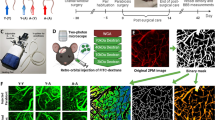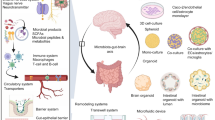Abstract
The blood–brain barrier (BBB) is a major obstacle for drug delivery to the brain. To seek for in vitro BBB models that are more accessible than animals for investigating drug transport across the BBB, we compared four in vitro cultured cell models: endothelial monoculture (bEnd3 cell line), coculture of bEnd3 and primary rat astrocytes (coculture), coculture with collagen type I and IV mixture, and coculture with Matrigel. The expression of the BBB tight junction proteins in these in vitro models was assessed using RT-PCR and immunofluorescence. We also quantified the hydraulic conductivity (L p), transendothelial electrical resistance (TER) and diffusive solute permeability (P) of these models to three solutes: TAMRA, Dextran 10K and Dextran 70K. Our results show that L p and P of the endothelial monoculture and coculture models are not different from each other. Compared with in vivo permeability data from rat pial microvessels, P of the endothelial monoculture and coculture models are not significantly different from in vivo data for Dextran 70K, but they are 2–4 times higher for TAMRA and Dextran 10K. This suggests that the endothelial monoculture and all of the coculture models are fairly good models for studying the transport of relatively large solutes across the BBB.









Similar content being viewed by others
References
Abbott, N. J. Astrocyte-endothelial interactions and blood-brain barrier permeability. J. Anat. 200:629–638, 2002.
Boveri, M., V. Berezowski, A. Price, S. Slupek, A. M. Lenfant, C. Benaud, T. Hartung, R. Cecchelli, P. Prieto, and M. P. Dehouck. Induction of blood-brain barrier properties in cultured brain capillary endothelial cells: comparison between primary glial cells and C6 cell line. Glia 51:187–198, 2005.
Bowman, P. D., S. R. Ennis, K. E. Rarey, A. L. Betz, and G. W. Goldstein. Brain microvessel endothelial cells in tissue culture: a model for study of blood-brain barrier permeability. Ann. Neurol. 14:396–402, 1983.
Braeckmans, K., L. Peeters, N. N. Sanders, S. C. De Smedt, and J. Demeester. Three-dimensional fluorescence recovery after photobleaching with the confocal scanning laser microscope. Biophys. J. 85:2240–2252, 2003.
Braga, J., J. M. Desterro, and M. Carmo-Fonseca. Intracellular macromolecular mobility measured by fluorescence recovery after photobleaching with confocal laser scanning microscopes. Mol. Biol. Cell 15:4749–4760, 2004.
Brown, R. C., A. P. Morris, and R. G. O’Neil. Tight junction protein expression and barrier properties of immortalized mouse brain microvessel endothelial cells. Brain Res. 1130:17–30, 2007.
Cancel, L. M., A. Fitting, and J. M. Tarbell. In vitro study of LDL transport under pressurized (convective) conditions. Am. J. Physiol. Heart Circ. Physiol. 293:H126–132, 2007.
Cancel, L. M., and J. M. Tarbell. The role of apoptosis in LDL transport through cultured endothelial cell monolayers. Atherosclerosis 208:335–341, 2010.
Crone, C., and S. P. Olesen. Electrical resistance of brain microvascular endothelium. Brain Res. 241:49–55, 1982.
Cucullo, L., M. S. McAllister, K. Kight, L. Krizanac-Bengez, M. Marroni, M. R. Mayberg, K. A. Stanness, and D. Janigro. A new dynamic in vitro model for the multidimensional study of astrocyte-endothelial cell interactions at the blood-brain barrier. Brain Res. 951:243–254, 2002.
Deli, M. A., C. S. Abraham, Y. Kataoka, and M. Niwa. Permeability studies on in vitro blood-brain barrier models: physiology, pathology, and pharmacology. Cell. Mol. Neurobiol. 25:59–127, 2005.
de Vries, H. E., M. C. M. BlomRoosemalen, M. van Oosten, A. G. deBoer, T. J. C. van Berkel, D. D. Breimer, and J. Kuiper. The influence of cytokines on the integrity of the blood-brain barrier in vitro. J. Neuroimmunol. 64:37–43, 1996.
Engvall, E. Structure and function of basement membranes. Int. J. Dev. Biol. 39:781–787, 1995.
Fletcher, N. F., D. J. Brayden, B. Brankin, S. Worrall, and J. J. Callanan. Growth and characterisation of a cell culture model of the feline blood-brain barrier. Vet. Immunol. Immunopathol. 109:233–244, 2006.
Fraser, P. A., A. D. Dallas, S. Davies, and P. A. Fraser. Measurement of filtration coefficient in single cerebral microvessels of the frog. J. Physiol. Lond. 423:343–361, 1990.
Gaillard, P. J., and A. G. de Boer. Relationship between permeability status of the blood-brain barrier and in vitro permeability coefficient of a drug. Eur. J. Pharm. Sci. 12:95–102, 2000.
Gumbleton, M., and K. L. Audus. Progress and limitations in the use of in vitro cell cultures to serve as a permeability screen for the blood-brain barrier. J. Pharm. Sci. 90:1681–1698, 2001.
Hamm, S., B. Dehouck, J. Kraus, K. Wolburg-Buchholz, H. Wolburg, W. Risau, R. Cecchelli, B. Engelhardt, and M. P. Dehouck. Astrocyte mediated modulation of blood-brain barrier permeability does not correlate with a loss of tight junction proteins from the cellular contacts. Cell Tissue Res. 315:157–166, 2004.
Haseloff, R. F., I. E. Blasig, H. C. Bauer, and H. Bauer. In search of the astrocytic factor(s) modulating blood-brain barrier functions in brain capillary endothelial cells in vitro. Cell. Mol. Neurobiol. 25:25–39, 2005.
Hawkins, B. T., and T. P. Davis. The blood-brain barrier/neurovascular unit in health and disease. Pharmacol. Rev. 57:173–185, 2005.
Hurwitz, A. A., J. W. Berman, W. K. Rashbaum, and W. D. Lyman. Human fetal astrocytes induce the expression of blood-brain barrier specific proteins by autologous endothelial cells. Brain Res. 625:238–243, 1993.
Johnston, H., P. J. Baker, M. Abel, H. M. Charlton, G. Jackson, L. Fleming, T. R. Kumar, and P. J. O’Shaughnessy. Regulation of Sertoli cell number and activity by follicle-stimulating hormone and androgen during postnatal development in the mouse. Endocrinology 145:318–329, 2004.
Karyekar, C. S., A. Fasano, S. Raje, R. L. Lu, T. C. Dowling, and N. D. Eddington. Zonula occludens toxin increases the permeability of molecular weight markers and chemotherapeutic agents across the bovine brain microvessel endothelial cells. J. Pharm. Sci. 92:414–423, 2003.
Kemper, E. M., W. Boogerd, I. Thuis, J. H. Beijnen, and O. van Tellingen. Modulation of the blood-brain barrier in oncology: Therapeutic opportunities for the treatment of brain tumours? Cancer Treat. Rev. 30:415–423, 2004.
Kleinman, H. K., and G. R. Martin. Matrigel: basement membrane matrix with biological activity. Semin. Cancer Biol. 15:378–386, 2005.
Koto, T., K. Takubo, S. Ishida, H. Shinoda, M. Inoue, K. Tsubota, Y. Okada, and E. Ikeda. Hypoxia disrupts the barrier function of neural blood vessels through changes in the expression of claudin-5 in endothelial cells. Am. J. Pathol. 170:1389–1397, 2007.
Kraus, J., K. Voigt, A. M. Schuller, M. Scholz, K. S. Kim, M. Schilling, W. R. Schabitz, P. Oschmann, and B. Engelhardt. Interferon-beta stabilizes barrier characteristics of the blood-brain barrier in four different species in vitro. Mult. Scler. 14:843–852, 2008.
Lawrence, J. R., G. M. Wolfaardt, and D. R. Korber. Determination of diffusion coefficients in biofilms by confocal laser microscopy. Appl. Environ. Microbiol. 60:1166–1173, 1994.
LeBleu, V. S., B. Macdonald, and R. Kalluri. Structure and function of basement membranes. Exp. Biol. Med. (Maywood, N.J.) 232:1121–1129, 2007.
Leblond, C. P., and S. Inoue. Structure, composition, and assembly of basement membrane. Am. J. Anat. 185:367–390, 1989.
Lee, S. W., W. J. Kim, J. A. Park, Y. K. Choi, Y. W. Kwon, and K. W. Kim. Blood-brain barrier interfaces and brain tumors. Arch. Pharm. Res. 29:265–275, 2006.
Malina, K. C., I. Cooper, and V. I. Teichberg. Closing the gap between the in-vivo and in-vitro blood-brain barrier tightness. Brain Res. 1284:12–21, 2009.
Michel, C. C., and F. E. Curry. Microvascular permeability. Physiol. Rev. 79:703–761, 1999.
Miosge, N. The ultrastructural composition of basement membranes in vivo. Histol. Histopathol. 16:1239–1248, 2001.
Nicolazzo, J. A., S. A. Charman, and W. N. Charman. Methods to assess drug permeability across the blood-brain barrier. J. Pharm. Pharmacol. 58:281–293, 2006.
Omidi, Y., L. Campbell, J. Barar, D. Connell, S. Akhtar, and M. Gumbleton. Evaluation of the immortalised mouse brain capillary endothelial cell line, b.End3, as an in vitro blood-brain barrier model for drug uptake and transport studies. Brain Res. 990:95–112, 2003.
Pardridge, W. M. Blood-brain barrier biology and methodology. J. Neurovirol. 5:556–569, 1999.
Poller, B., H. Gutmann, S. Krahenbuhl, B. Weksler, I. Romero, P. O. Couraud, G. Tuffin, J. Drewe, and J. Huwyler. The human brain endothelial cell line hCMEC/D3 as a human blood-brain barrier model for drug transport studies. J. Neurochem. 107:1358–1368, 2008.
Sahagun, G., S. A. Moore, and M. N. Hart. Permeability of neutral vs. anionic dextrans in cultured brain microvascular endothelium. Am. J. Physiol. 259:H162–166, 1990.
Salvetti, F., P. Cecchetti, D. Janigro, A. Lucacchini, L. Benzi, and C. Martini. Insulin permeability across an in vitro dynamic model of endothelium. Pharm. Res. 19:445–450, 2002.
Santaguida, S., D. Janigro, M. Hossain, E. Oby, E. Rapp, and L. Cucullo. Side by side comparison between dynamic versus static models of blood-brain barrier in vitro: a permeability study. Brain Res. 1109:1–13, 2006.
Shi, Z. D., X. Y. Ji, D. E. Berardi, H. Qazi, and J. M. Tarbell. Interstitial flow induces MMP-1 expression and vascular SMC migration in collagen I gels via an ERK1/2-dependent and c-Jun-mediated mechanism. Am. J. Physiol. Heart Circ. Physiol.. 298:H127–H135, 2010.
Soga, N., J. O. Connolly, M. Chellaiah, J. Kawamura, and K. A. Hruska. Rac regulates vascular endothelial growth factor stimulated motility. Cell Commun. Adhes. 8:1–13, 2001.
Sugaya, R., B. A. Wolf, and R. Kita. Thermal diffusion of dextran in aqueous solutions in the absence and the presence of urea. Biomacromolecules 7:435–440, 2006.
Thompson, S. E., J. Cavitt, and K. L. Audus. Leucine-enkephalin effects on paracellular and transcellular permeation pathways across brain microvessel endothelial-cell monolayers. J. Cardiovasc. Pharmacol. 24:818–825, 1994.
Tyagi, N., K. S. Moshal, U. Sen, T. P. Vacek, M. Kumar, W. M. Hughes, Jr, S. Kundu, and S. C. Tyagi. H2S protects against methionine-induced oxidative stress in brain endothelial cells. Antioxid. Redox Signal. 11:25–33, 2009.
Wang, H., S. Y. Yan, H. Chai, G. M. Riha, M. Li, Q. Z. Yao, and C. Y. Chen. Shear stress induces endothelial transdifferentiation from mouse smooth muscle cells. Biochem. Biophys. Res. Commun. 346:860–865, 2006.
Wang, R. S., S. Yeh, L. M. Chen, H. Y. Lin, C. X. Zhang, J. Ni, C. C. Wu, P. A. di Sant’Agnese, K. L. DeMesy-Bentley, C. R. Tzeng, and C. S. Chang. Androgen receptor in sertoli cell is essential for germ cell nursery and junctional complex formation in mouse testes. Endocrinology 147:5624–5633, 2006.
Yamamoto, K., T. Sokabe, T. Watabe, K. Miyazono, J. K. Yamashita, S. Obi, N. Ohura, A. Matsushita, A. Kamiya, and J. Ando. Fluid shear stress induces differentiation of Flk-1-positive embryonic stem cells into vascular endothelial cells in vitro. Am. J. Physiol. Heart Circ. Physiol. 288:H1915–H1924, 2005.
Yoder, E. J. Modifications in astrocyte morphology and calcium signaling induced by a brain capillary endothelial cell line. Glia 38:137–145, 2002.
Yuan, W., G. Li, and B. M. Fu. Effect of surface charge of immortalized mouse cerebral endothelial cell monolayer on transport of charged solutes. Ann. Biomed. Eng. 2010 Jan 20. Epub ahead of print.PMID: 20087768.
Yuan, W., Y. Lv, M. Zeng, and B. M. Fu. Non-invasive measurement of solute permeability in cerebral microvessels of the rat. Microvasc. Res. 77:166–173, 2009.
Zhang, Y., C. S. W. Li, Y. Y. Ye, K. Johnson, J. Poe, S. Johnson, W. Bobrowski, R. Garrido, and C. Madhu. Porcine brain microvessel endothelial cells as an in vitro model to predict in vivo blood-brain barrier permeability. Drug Metab. Dispos. 34:1935–1943, 2006.
Acknowledgments
This work was supported in part by the Andrew Grove Foundation, the National Science Foundation CBET-0133775 and CBET-0754158, PSC-CUNY research award of the City University of New York, and the National Institutes of Health grant HL57093.
Author information
Authors and Affiliations
Corresponding author
Additional information
Associate Editor Gerald Saidel oversaw the review of this article.
Rights and permissions
About this article
Cite this article
Li, G., Simon, M.J., Cancel, L.M. et al. Permeability of Endothelial and Astrocyte Cocultures: In Vitro Blood–Brain Barrier Models for Drug Delivery Studies. Ann Biomed Eng 38, 2499–2511 (2010). https://doi.org/10.1007/s10439-010-0023-5
Received:
Accepted:
Published:
Issue Date:
DOI: https://doi.org/10.1007/s10439-010-0023-5




